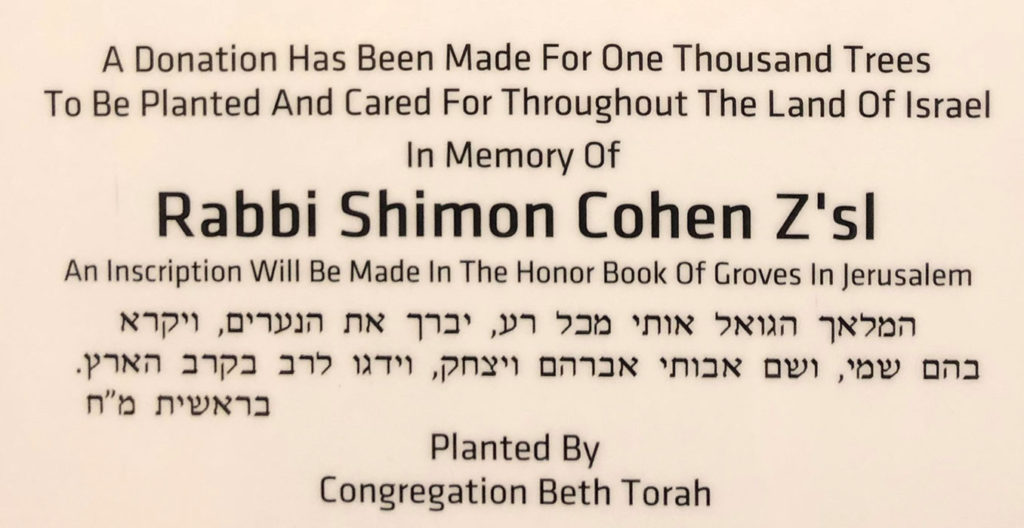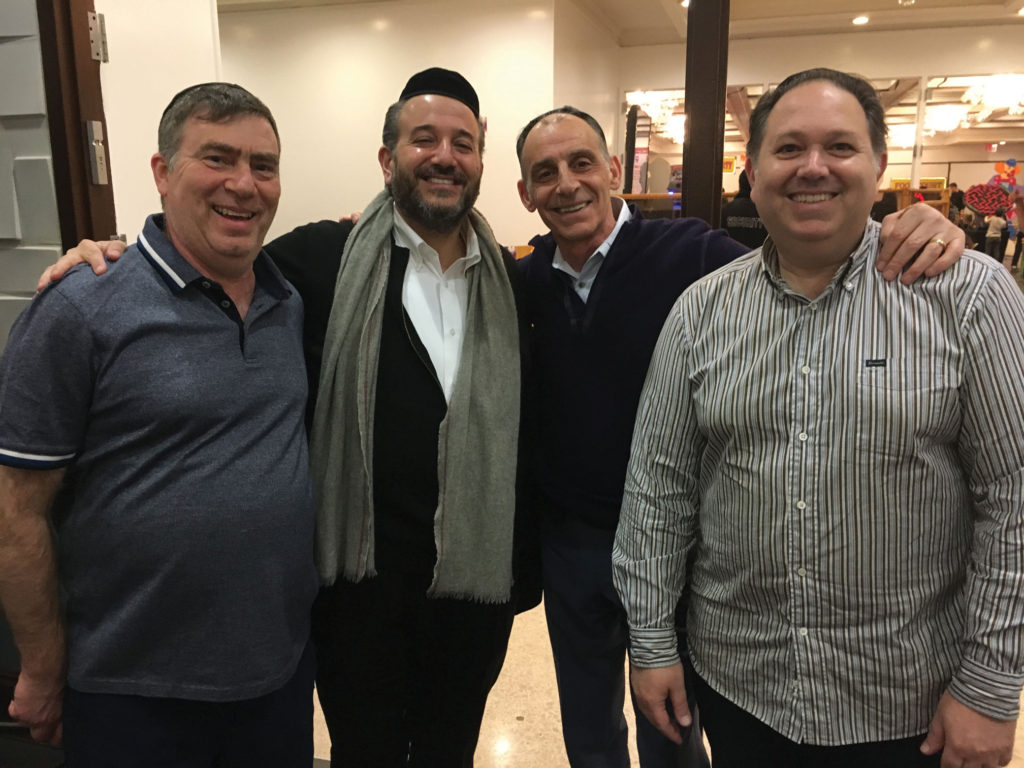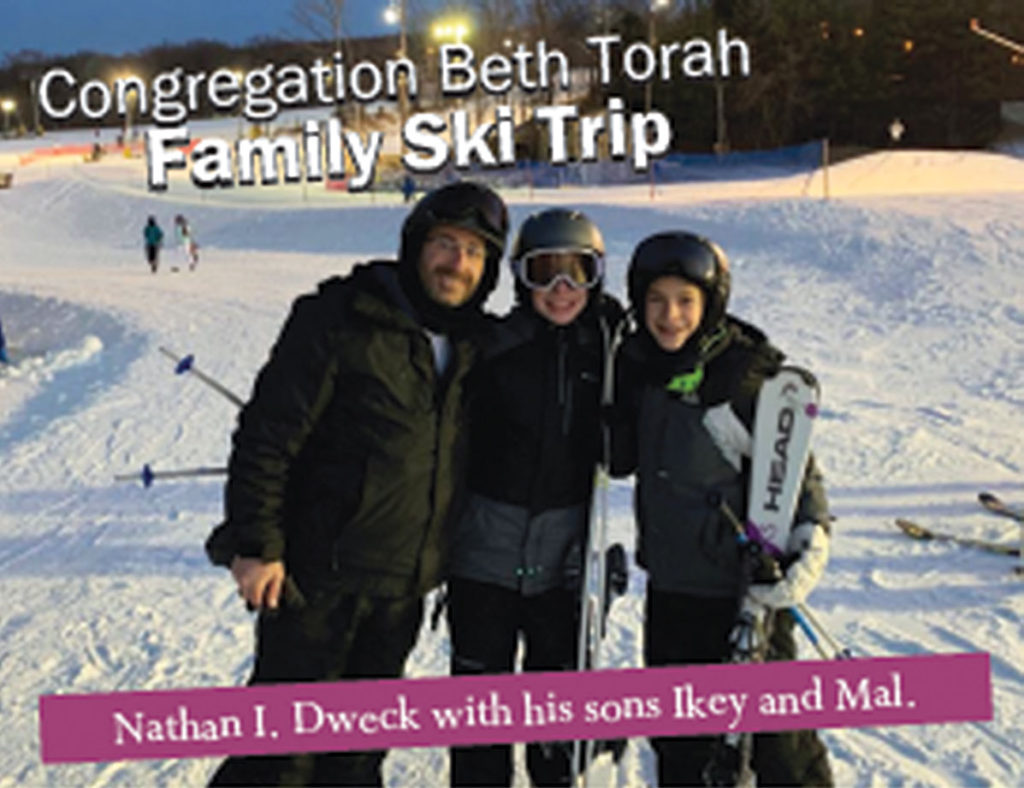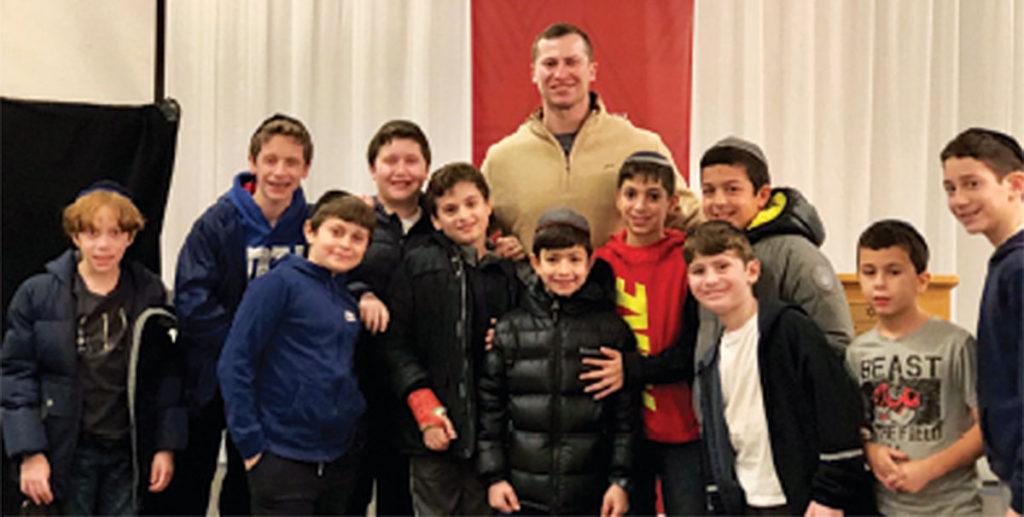
IT’S ALL ABOUT THE CHILDREN
SARINA ROFFÉ

TWENTY-FIVE YEARS AGO, I BEGAN ATTENDING THE CHILDREN’S MINYAN AT CONGREGATION BETH TORAH ON SATURDAY MORNINGS WITH MY YOUNGEST SON. IT WAS A FEW YEARS BEFORE HIS BAR MITZVAH. AS WE WALKED IN THE DOOR, WE WERE WELCOMED WITH OPEN ARMS BY RABBI SHIMON COHEN A”H AND SEVERAL OF THE GUYS WHO VOLUNTEERED THEIR TIME DURING THE SERVICE. RABBI COHEN’S ENERGY FILLED THE ROOM AS HE HUGGED EACH CHILD, HIS WARM SMILE EMBRACING THEM WITH LOVE. THE VOLUNTEERS WERE THE UNSUNG HEROES WHOSE WORK ON SUNDAY MORNINGS ASSURED THAT THE SERVICE RAN SMOOTHLY, THAT THERE WERE TOYS, PRIZES, AND FOOD FOR THE FOLLOWING SHABBAT.
Ronnie Gindi happily gave out lollipops, stashed in all his pockets, and made crying toddlers happy, his smile beaming throughout the room. Then there was Moe Kishk, who kept my son on task, and others who assigned the weekly portions to the children so they could practice for the next week. The ambiance was of a warm welcoming home with the volunteers who made it happen, week in and week out.
Gone was the stilted stuffy feel of simply praying. The children were motivated with positive reinforcement, a sense of accomplishment and rewards for their efforts. Of course, the underlying reason for the minyan was to teach Torah and community values. Moreover, the children wanted to be there. There was a sense of family and togetherness. And while many of the fathers may have preferred to sleep in after a long week at work, their children pushed them to attend services.
The Beth Torah Children’s Minyan began about 40 years ago with Dr. Ezra Cohen, Abie Hanono, Moe Kishk, Allan Menaged and another humble gentleman we shall call Mr. Hesed, because he asked to remain anonymous. Within a year, Abie Hanono had recruited Rabbi Cohen for the minyan and in turn, Rabbi Cohen recruited Ronnie Gindi as a volunteer. Of the original group, Mr. Hesed and Ronnie Gindi remain, while others have stepped in—Joe Chappan, Ralph Terzi, Sol Wahba, Victor Znati, Morris Varon, and others. Rabbi David Shelby was hired to fill the huge shoes of Rabbi Cohen, who passed on in 2016.
“We wanted to get the kids away from their television sets and into the synagogue,” said Moe Kishk. “The kids wanted to come to get the ice cream and toys, and they had to drag their parents. Some fathers who never came to shul started to come with their kids.”
“Before the minyan, we had kids roaming streets. They didn’t want to sit with their fathers in the main shul. Kids needs are different and they needed to be able to participate so we started something more interactive and participatory,” said Dr. Ezra Cohen.
“The future of the shul is our children. We gave them incentives. We held mini trips, went fishing, and had carnivals with prizes. Moe Kishk and I used to make tuna fish for seuda selushit. The rabbi gave them tapes to learn parts for the Shabbat service. We did silly things like give them tickets to a baseball game. With these incentives, they became regulars. Many of them continue to learn and have become leaders. Now they bring their children.”
Indeed, Rabbi Eli Mansour was one of those children. “Rabbi Cohen had a huge impact on me and my friends,” he said. “He had tremendous energy and we felt it. Because of him, we got to read, and we became more comfortable reading, and many are hazzanim today. We learned the minhagim and how to pray. He mentored us for several years and built our self-confidence.”
Indeed, Rabbi Cohen’s influence will live on for generations. The overwhelming majority of those students live Torah observant lives. Rabbi Cohen was the paragon of this virtue, going to endless lengths to connect to the essence of each child. The peripheral effect that this had on the many families of these students is staggering.
Rabbi Mansour said “It was the lay leaders behind the scenes who were instrumental in making it all happen. These were prominent men who could have prayed upstairs in the main sanctuary. If you ask them, they will say that the future of Beth Torah and or the community, is in the basement, not the first floor. They understood the importance of directing their energy to the youth.”

Ralph Terzi was a student of Rabbi Cohen when he attended Magen David Yeshivah. He said Rabbi Cohen encouraged him to come to Beth Torah when he was just 10 years old. Each week the Rabbi gave him tasks to do. “One week it was setting up chairs, then it was putting away books. Every week, he added a thing I had to do.” That was 25 years ago.

Now Ralph brings his three sons there and volunteers each week. “I want them to feel the same energy I did when I was 12. It all started with Rabbi Cohen. He loved working with the children and that satisfaction has propelled me forward. Every time I see a boy go up to the Torah and read for the first time, I am seeing the results of carrying our traditions forward to the next generation.”
“Rabbi Cohen loved every child no matter how old they were,” said Moe. “He hugged them and welcomed them as if they were kings. Every child got his big smile. I worked with him for 25 years. He attracted a lot of kids and they will never forget him. Rabbi Cohen was a walking mezuzah, everyone came to kiss him.”
BEHIND THE SCENES
The lay leaders in the synagogue, the volunteers who operate behind the scenes of Beth Torah Children’s Minyan, are there week in and week out, one for 38 years, another for 35 years, and so on.
Take Mr. Hesed. Responsible for the games, prizes, backpacks and toys at Simchat Torah, he works all year collecting items, making deals with toy vendors, and going to Costco or BJ’s to buy items. He devotes a full section of his warehouse to storing the items. Not by himself, others help as well because the job is too big for one person.
“One day he (Mr. Hesed) heard about a closeout and took his truck to go pick up the goods. He lost a half day’s work. He did it silently, by himself, and did not want any credit. He even goes to Carvel to get the kids ice cream,” said Dr. Cohen. “He is an unsung hero.”
Ronnie Gindi learned to give out lollipops and candy from his father, Jack Gindi, who did it years ago at Congregation Shaare Zion. He has been a volunteer at the Beth Torah Children’s minyan for 35 years, week in and week out.
“My job is to make sure no one goes home unhappy. We want the children to come back, to feel like the synagogue is the place to be,” said Ronnie. “We have about 300 kids each week and we give out about 35 prizes. We also supply Morah Etti, Ms. Stern’s group, Rabbi Joe Mizrahi’s minyan and others. We buy a lot of stuff in bulk, as well as candy and ice cream.
“We are world famous for the minyan. It’s a very big high for a father to see his son read and we make a big deal for each child. It’s unbelievably fantastic. The kid walks away and feels like he won the lottery.”
Ronnie Gindi was in Rabbi Cohen’s first class at Magen David Yeshivah. “He changed me as a kid,” Ronnie said. “He was a substitute teacher at Magen David in a particularly difficult class and the students challenged him. But he changed them. And they grew to love him. When he wanted me to help in the children’s minyan, I told him I was a rebel. I’m a big sports guy. I played high school and college basketball. I figured I would help for two weeks and be done. But now here I am, in my 35th year.
“When my kids began getting older, I wanted to go to shul with my adult children, Rabbi Cohen said ‘This is more important. You must stay with the kids’ program’ and it was a promise I made to him to keep the minyan thriving.”
On Simchat Torah alone, the volunteers prepare 1,500 backpacks for children who seem to come out of the woodwork that day. According to Ronnie, “One time I said to Rabbi Cohen ‘Most of these kids just come for the backpacks, they don’t attend. Rabbi Cohen said ‘Are they Jewish?’ Yes. ‘Are they children?’ Yes. ‘Then give them a bag.’ He taught us how important the children are.”
“It’s like a choreographed show,” said Sol Wahba, who among a thousand myriad tasks orchestrates the carnivals. “Who will do this and who will do that, every 15 minutes. Everyone does their part and no one gets credit. “Sometimes we run short and we have to run to BJ’s and buy candy, and some are putting thousands of dollars on their personal credit cards. Who wants to do that on a Saturday night? And then bring it back and unload it for the next week. But we do it for the children.
“It’s Hashem putting you in the place and you have the ability to do something others can’t. At the same time, there has to be a balance between praying, giving out candy and decorum. The main thing is to keep everyone happy and do it with a smile.”
“This past year or so was hard. We did drive-bys for Hanukkah and Simchat Torah, a virtual Chinese Auction and creative things to keep the children engaged.”
THE NEXT GENERATION: RABBI DAVID SHELBY
Not long after Rabbi Shimon Cohen became ill and then passed away, Rabbi David Shelby was recruited to run the minyan. Rabbi Shelby had big shoes to fill, as Rabbi Cohen was considered a giant.

The volunteers say he was a perfect fit, as he emanates the same warmth Rabbi Cohen did, his ear-to-ear smile welcoming the children.
“Rabbi Shelby has the same demeanor. His warmth attracts people,” said Ralph.
“It’s the biggest kids minyan in the community and he (Rabbi Cohen) was the greatest of the great,” said Rabbi Shelby. “He taught us how to sing in the rain instead of waiting for the rain to pass; I knew him my entire life. I worked with him in Magen David.
“I have a lot of respect for the volunteers who commit themselves to the service. It’s hard to volunteer. They get no glory or recognition, only aggravation. It’s noisy and there is a lot of action, and they still do it. You would think they would get tired.
“I think of it as a life lesson. When you park you are sitting still; when you drive, you are moving forward. The minyan is motivation in drive. We can’t sit back and pray and hope. We take action and do something. These volunteers have memories from when they were children, and they want the kids to have those same positive memories. The kids will remember an upscale Purim party or a fishing or basketball trip.
“These guys keep the legacy going. And besides the minyan, they do other things for the kids. Every Sukkot, Mr. Hesed buys extra lulav and etrogim. If a kid comes to shul without one because he can’t afford it, Mr. Hesed doesn’t want the child to feel out of place, so he gives them out. And not every child is as learning-abled as others, so Mr. Hesed pays for private tutoring for some kids.
The kids come to shul to get a prize and candy, but the underlying goal is to teach them, which in turn nurtures the heritage and preserves the traditions of our community. And these same volunteers help out all the other synagogues in the community, as well as those in Deal during the summer. It’s all about the children.
These volunteers are unsung heroes who make it all happen.
A genealogist and historian, Sarina Roffé is the author of Branching Out from Sepharad and cookbooks. She is President of the Sephardic Heritage Project, Co-Chair of the Brooklyn Jewish Historical Initiative and Chair of the Sephardic Research Division of JewishGen. Editor of the journal Dorot, Sarina holds a BA in Journalism, and an MA in Jewish Studies and an MBA.



